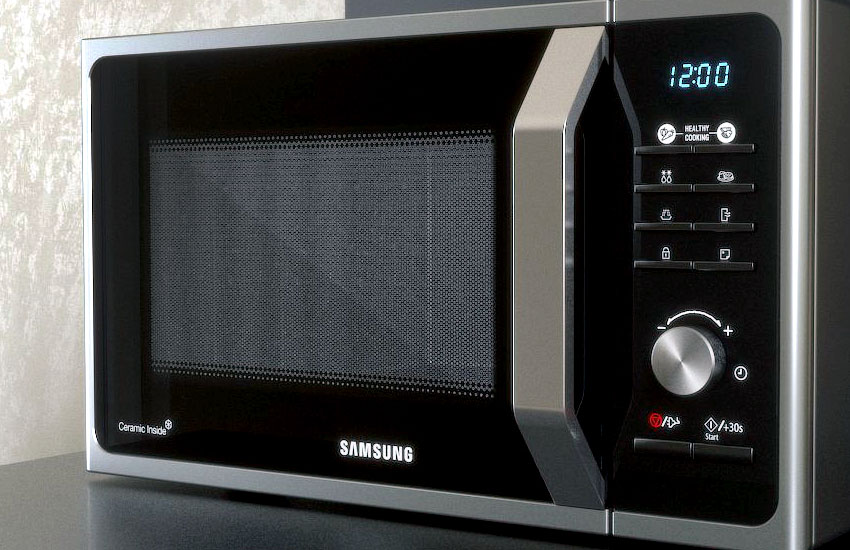As an Amazon Associate, I earn from qualifying purchases at no extra cost to you.
How to Reset Your Samsung Microwave: The Ultimate Guide
Microwaves are one of those appliances we all take for granted until they stop working properly. If you’ve been having trouble with your Samsung microwave, don’t worry—resetting it might be the easiest fix! Whether the display has frozen, settings are off, or it’s not heating your food as it should, a reset can often solve the issue in no time. In this guide, we’ll walk you through how to reset your Samsung microwave in the simplest way possible. By the end, you’ll feel like a microwave pro and get back to enjoying your meals without frustration!

Understanding Why You Might Need to Reset Your Samsung Microwave
When your Samsung microwave isn’t working right, it can be super frustrating. From buttons not responding to the microwave seemingly losing power, it can make you wonder what went wrong. The truth is, many issues are fixable with a simple reset.
Common Reasons for a Reset
A reset can help with several common problems that might occur, such as:
- Frozen or unresponsive display: Sometimes, the microwave’s display screen can freeze, and the buttons might stop working. This could be due to a minor glitch in the microwave’s software, and a reset might bring things back to normal.
- Power outages: If there’s been a power cut, your microwave may need to be reset to start working again. Some Samsung microwaves have a memory feature that gets wiped after power interruptions, so resetting can help restore it to working condition.
- Error codes: If you see error codes like “SE,” “H98,” or others flashing on the screen, these can sometimes be fixed by resetting the microwave.
So, why does resetting the microwave solve these issues? It’s all about clearing out minor glitches or temporary errors that might have popped up. Think of it like restarting your computer when it freezes—you’re just giving the microwave a fresh start.
Common Issues That Can Be Fixed by Resetting Your Microwave
Before we dive into the actual resetting process, it’s good to know exactly what issues resetting will help fix. Here are a few common problems that can usually be resolved with a reset:
1. Microwave Not Turning On or Heating Food
If your microwave isn’t turning on or not heating food, there’s a chance that a minor software glitch or internal reset might solve the issue. A reset is often the first step when troubleshooting, and it can save you the hassle of thinking something more serious is wrong.
2. Control Panel Not Responding
Microwaves are complex machines with touch-sensitive control panels, and sometimes they can become unresponsive. This could be due to moisture buildup, electrical issues, or a temporary software issue. Resetting the microwave can fix an unresponsive control panel, saving you from needing a costly repair.
3. Microwave Display Freezing
If your microwave’s display freezes or doesn’t change when you press buttons, a reset might restore the screen to normal functionality. This is one of the most common issues that many users report, and it’s often easily solved with a reset.
4. Error Codes or Malfunctions
Seeing strange error codes like “SE” or “H98” on your microwave’s display? Don’t panic. These error codes are often caused by electrical glitches or a miscommunication between the microwave’s internal components. Resetting your Samsung microwave can often clear these errors and make your microwave work normally again.
So, before calling in a technician, trying a reset first is always worth it. It’s a simple and easy step that can fix many issues.
How to Perform a Soft Reset on Your Samsung Microwave
A soft reset is like giving your microwave a quick restart. It’s the easiest and quickest solution to try first when your microwave isn’t working properly. Here’s how you can perform a soft reset on your Samsung microwave:
Step 1: Unplug the Microwave
The first thing you’ll need to do is unplug the microwave from the wall outlet. Unplugging it ensures that all the electrical components reset. Wait for at least 30 seconds before plugging it back in. This gives the microwave time to fully power down and reset its internal systems.
Step 2: Plug the Microwave Back In
After waiting, plug the microwave back into the outlet. Once plugged in, you should see the microwave’s display light up. If your microwave has a touchpad, it might ask you to reset the time or other settings. You may also see the microwave’s display flashing for a moment before it settles into its regular screen.
Step 3: Check If the Microwave Works
Once the microwave is plugged back in, try using it to see if the problem is fixed. Test the buttons, settings, and heating function to ensure everything is working. If it’s working fine now, then the soft reset has done its job.
A soft reset is often all you need for common issues, but if you’re still experiencing problems, it may be time to try a more thorough reset.
Steps for a Hard Reset: A More Thorough Solution
Sometimes, you need to perform a more thorough reset to resolve stubborn issues. This is known as a hard reset. If a soft reset didn’t do the trick, try the hard reset process below.
Step 1: Disconnect the Microwave Completely
To start, you’ll need to completely disconnect your microwave from the power source. This means unplugging it and, if possible, turning off the circuit breaker that powers the microwave. This ensures the microwave is fully disconnected from any power.
Step 2: Wait for 5 Minutes
Once you’ve unplugged the microwave and turned off the circuit breaker (if applicable), wait for about 5 minutes. This might seem like a long time, but waiting helps clear the microwave’s internal systems of any residual electricity or temporary memory that could be causing the issue.
Step 3: Turn On the Power Again
After 5 minutes, plug the microwave back in and turn the circuit breaker back on (if applicable). The microwave should start up as if it’s new. You might need to set the clock, and some microwaves will ask you to confirm the language or other settings.
Step 4: Test the Microwave
Once the microwave has powered up, test its functions. Try heating food, using different settings, and checking the control panel. If everything is working properly now, you’ve successfully completed a hard reset. If not, it might be time to explore other troubleshooting steps or contact customer support.
Why You Might Need a Hard Reset
Hard resets are generally used when soft resets don’t resolve the issue, such as in cases where the microwave has more complex internal issues or if the control panel continues to malfunction.
How to Reset the Microwave’s Control Panel or Settings
Your Samsung microwave’s control panel is the brain of the appliance, and sometimes it can get out of sync. Resetting the control panel or settings can fix issues where buttons are unresponsive or settings have gone wrong. Here’s how you can do it:
Step 1: Turn Off the Microwave
The first thing you need to do is turn off your microwave completely. You can either press the “Stop/Cancel” button or simply unplug the appliance for a few seconds.
Step 2: Press the “Stop/Cancel” Button
Once the microwave is powered off, press and hold the “Stop/Cancel” button for 10-15 seconds. This can reset the control panel and clear any temporary glitches that may have caused the problem.
Step 3: Restore Default Settings
If the control panel still isn’t responding after the reset, try restoring the default settings. You can do this by following the instructions in your microwave’s user manual or by pressing certain combinations of buttons, like holding the “Start” button and “Power Level” button simultaneously for several seconds.
Step 4: Test the Microwave
After restoring the default settings, check to see if the control panel is now responsive. Test the settings and buttons to ensure they’re functioning normally.
Resetting the Samsung Microwave After a Power Outage
Power outages can cause microwaves to lose their settings or stop working temporarily. After the power comes back on, it might be necessary to reset your microwave to restore its full functionality.
Step 1: Unplug the Microwave
Start by unplugging your Samsung microwave from the power source. This will allow the microwave to fully reset and remove any issues caused by the power outage.
Step 2: Wait for 30 Seconds to 1 Minute
Leave the microwave unplugged for at least 30 seconds, but ideally 1 minute. This gives the appliance time to reset its internal systems and clear any potential glitches caused by the power interruption.
Step 3: Plug the Microwave Back In
After waiting, plug the microwave back into the electrical outlet. You should see the microwave’s display light up and ask you to set the clock or confirm settings.
Step 4: Test the Microwave
Once the microwave is plugged in, test its functions to ensure it’s working again. If there are still issues, try performing a soft or hard reset.
What to Do If Resetting Doesn’t Fix Your Microwave
If you’ve tried resetting your Samsung microwave and the issue persists, don’t lose hope just yet. Here are a few other steps you can take:
Check for External Factors
Make sure there isn’t an issue with the electrical outlet or the power supply to your microwave. Try plugging the microwave into a different outlet to rule out the possibility of a power issue.
Inspect the Microwave’s Door
Sometimes, the microwave won’t work properly if the door is misaligned or not closing correctly. Make sure the door is fully closed and that the latch isn’t broken.
Consult the User Manual
Your microwave’s user manual may have specific troubleshooting steps for your model. If you still can’t figure out the issue, it’s a good idea to consult the manual for additional guidance.
Contact Customer Support
If all else fails, it may be time to contact Samsung’s customer support for assistance. They can guide you through more advanced troubleshooting steps or recommend repairs if necessary.
Tips for Maintaining Your Samsung Microwave for Longevity
While resetting your microwave can fix temporary issues, maintaining it regularly will help prevent future problems. Here are some tips to keep your microwave in good shape:
- Clean Regularly: Wipe down the inside of your microwave and clean the control panel frequently to avoid buildup of dirt and grime.
- Avoid Overloading: Don’t overload the microwave with food. This can cause overheating and strain the microwave’s internal components.
- Use Microwave-Safe Containers: Always use microwave-safe containers and avoid placing metal or non-safe materials inside the microwave.
Frequently Asked Questions
Is it possible to reset a Samsung microwave without unplugging it?
Yes, you can reset some Samsung microwaves by pressing and holding specific buttons. However, unplugging it is the most effective way.
Can resetting a microwave fix a broken control panel?
Resetting the microwave might help if the control panel is unresponsive due to a minor glitch, but a broken control panel often requires repair.
Do I need to reset my microwave after a power surge?
Yes, after a power surge, it’s recommended to reset your microwave to ensure it functions properly.
Is it safe to perform a hard reset on my microwave?
Yes, performing a hard reset is safe. Just make sure to follow the steps correctly to avoid any damage.
Can I reset my Samsung microwave to factory settings?
Yes, you can reset your microwave to factory settings, but this will erase all custom settings, including clock and language preferences.
Is it normal for the microwave to beep during a reset?
Yes, some models beep to confirm that a reset is in progress.
Can resetting fix a microwave that’s not heating?
If the issue is a minor glitch, resetting might help. However, if the microwave isn’t heating, it could be a more serious problem that requires repair.
Do I need professional help if resetting doesn’t work?
If resetting doesn’t solve the problem, it may be time to contact customer support or a professional repair technician.
I hope this guide helped you feel more confident about resetting your Samsung microwave. Whether it’s a quick soft reset or a thorough hard reset, these steps should get your microwave back to normal in no time. Don’t forget to maintain it to avoid future issues, and remember, if you ever need help, Samsung’s customer service is there for you!



